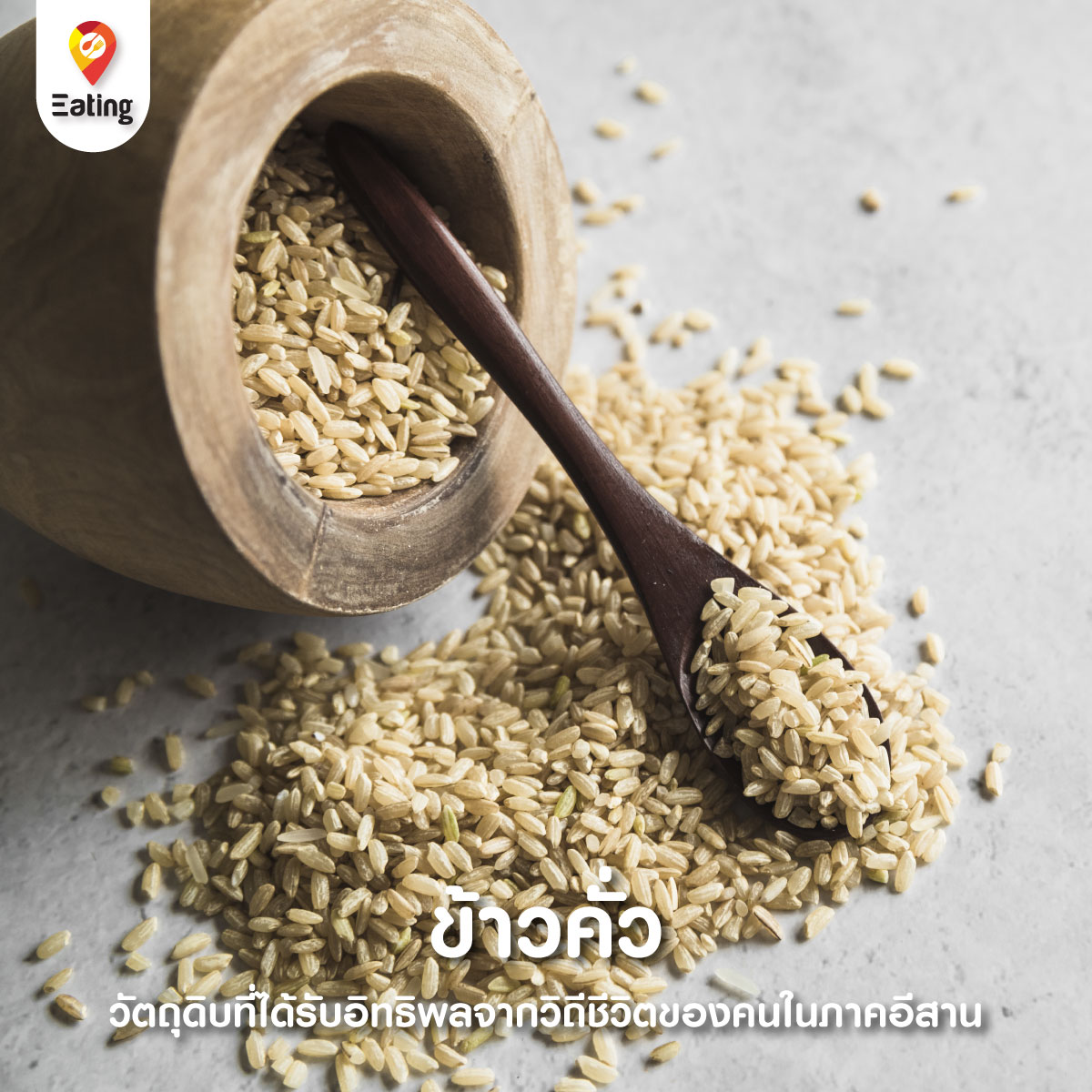Insider
New Experience

ข้าวคั่ว
วัตถุดิบที่ได้รับอิทธิพลจาก วิถีชีวิตของคนในภาคอีสาน
ข้าวคั่ว เป็นวัตถุดิบสำคัญในอาหารไทย โดยเฉพาะในอาหารอีสานและอาหารเหนือ มีลักษณะเป็นข้าวสารที่นำไปคั่วให้เหลืองหอม ก่อนนำมาโขลกหรือตำให้เป็นผงหยาบเพื่อนำไปใช้เป็นส่วนผสมในอาหารต่าง ๆ
.
ข้าวคั่วมีรากฐานมาจากวิถีชีวิตของชาวไทยภาคอีสานและล้านนา ซึ่งเป็นภูมิภาคที่นิยมใช้ข้าวเป็นวัตถุดิบหลัก การนำข้าวไปคั่วและตำให้เป็นผงเกิดจากภูมิปัญญาพื้นบ้านที่ช่วยเพิ่มความหอมและรสชาติให้กับอาหาร อีกทั้งยังช่วยให้เนื้อสัมผัสของอาหารมีความข้นและเข้ากันได้ดีมากขึ้น
.
ข้าวคั่วมีการใช้มาอย่างยาวนานในเมนูพื้นบ้าน เช่น ลาบ ก้อย น้ำตก และแจ่ว ซึ่งเป็นอาหารที่ต้องการเนื้อสัมผัสที่กรุบกรอบเล็กน้อยจากข้าวคั่ว รวมถึงช่วยซับความชื้นและทำให้รสชาติของอาหารกลมกล่อมขึ้น
.
การทำข้าวคั่วมักใช้ ข้าวเหนียว หรือ ข้าวเจ้า แล้วนำไปคั่วในกระทะด้วยไฟอ่อนจนเมล็ดข้าวเปลี่ยนเป็นสีเหลืองทองและมีกลิ่นหอม จากนั้นจึงนำไปตำหรือบดให้เป็นผงหยาบ
.
เพิ่มรสชาติและกลิ่นหอม – ช่วยให้เมนูที่ใช้ข้าวคั่วมีกลิ่นหอมน่ารับประทาน
เพิ่มเนื้อสัมผัส – ทำให้อาหารมีความกรุบกรอบเล็กน้อย
ช่วยซับความชื้น – ทำให้อาหารคงรสชาติและไม่แฉะจนเกินไป
.
ในปัจจุบัน ข้าวคั่วยังคงเป็นส่วนสำคัญของอาหารไทย โดยเฉพาะอาหารอีสานและอาหารเหนือ นอกจากนี้ยังถูกนำไปใช้ในเมนูอาหารฟิวชันและอาหารเพื่อสุขภาพ เนื่องจากเป็นวัตถุดิบจากธรรมชาติที่ไม่ผ่านการปรุงแต่งมากนัก
.
ข้าวคั่วจึงเป็นทั้งเครื่องปรุงและส่วนผสมที่สะท้อนภูมิปัญญาท้องถิ่น และยังคงเป็นส่วนสำคัญของวัฒนธรรมการกินของคนไทยมาจนถึงปัจจุบัน
Khao Kua (toasted rice powder) is an essential ingredient in Thai cuisine, particularly in Isaan (Northeastern) and Northern Thai dishes. It is made by dry-roasting raw rice until golden brown and fragrant, then pounding or grinding it into a coarse powder for use in various dishes.
.
Khao Kua originates from the traditional lifestyles of people in Isaan and Lanna regions, where rice is a staple ingredient. The process of toasting and grinding rice into powder is a local culinary technique that enhances aroma and flavor while also improving the texture and consistency of food.
.
For generations, Khao Kua has been used in classic Thai dishes such as larb (spicy minced meat salad), koi, nam tok (grilled meat salad), and jaew (spicy dipping sauce). It adds a subtle crunch, absorbs excess moisture, and helps create a well-balanced taste.
How Khao Kua Is Made
Typically, either sticky rice or jasmine rice is used. The rice is dry-roasted in a pan over low heat until it turns golden brown and releases a nutty fragrance. It is then pounded or ground into a coarse powder, ready to be incorporated into various dishes.
.
Benefits of Using Khao Kua
![]() Enhances flavor and aroma – Adds a rich, toasty fragrance to dishes.
Enhances flavor and aroma – Adds a rich, toasty fragrance to dishes.
![]() Improves texture – Provides a slightly crunchy, satisfying bite.
Improves texture – Provides a slightly crunchy, satisfying bite.
![]() Absorbs moisture – Helps maintain consistency and prevents dishes from becoming too watery.
Absorbs moisture – Helps maintain consistency and prevents dishes from becoming too watery.
.
Khao Kua in Modern Cuisine
Today, Khao Kua remains a staple in Thai cooking, particularly in Isaan and Northern Thai cuisine. It is also gaining popularity in fusion dishes and healthy recipes, as it is a natural, unprocessed ingredient that enhances both flavor and texture.
.
Khao Kua is more than just a seasoning—it is a testament to local culinary wisdom and remains an integral part of Thai food culture to this day.